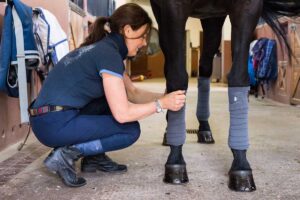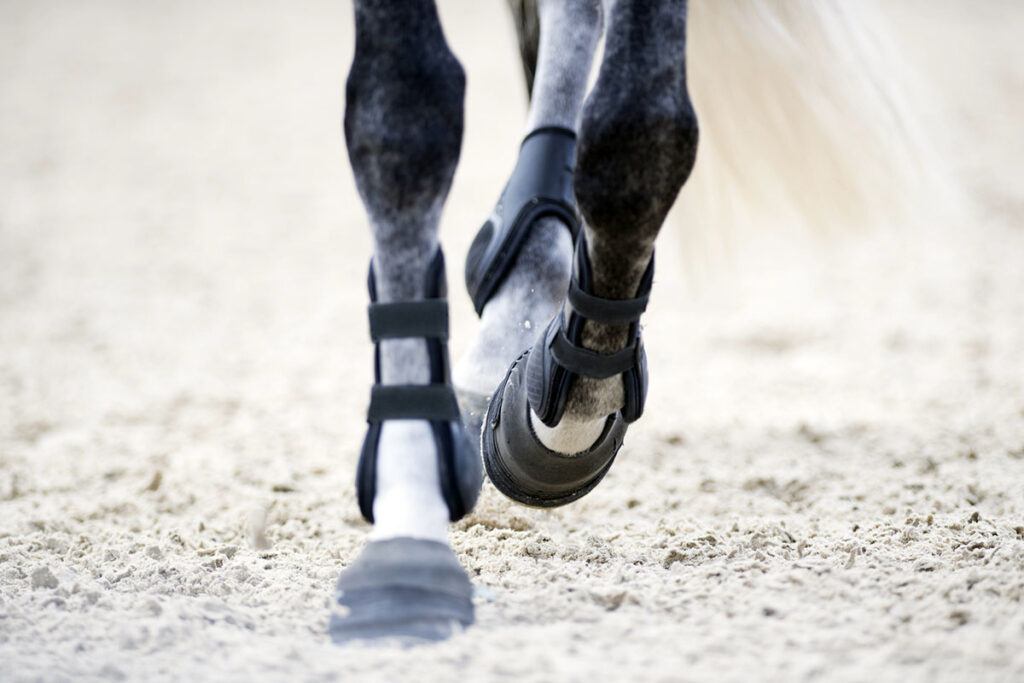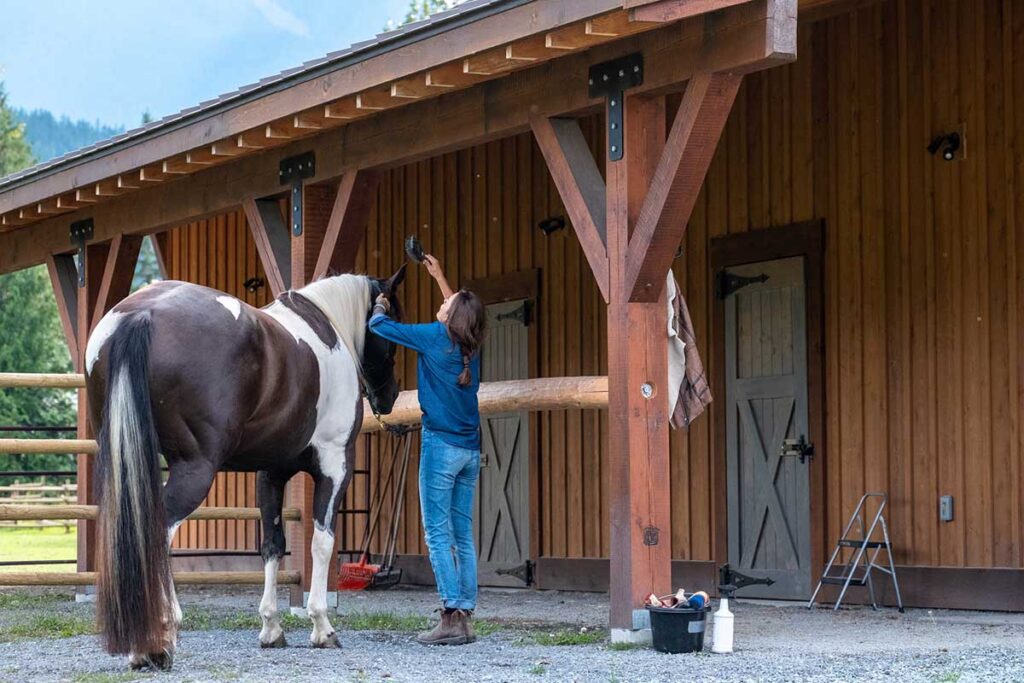Horses’ lower legs—slender, exposed, and lacking protective muscles—are vulnerable to injury if they hit hard objects or strike their own limbs. For this reason, manufacturers have created countless kinds of equine leg protection, depending on the horse’s needs and the situation. In this article, we’ll describe the types available, their uses, and how to care for them.
Protection While Shipping Horses

If you’ve ever had to stand on a public bus, you know when it turns a corner, you have to lean and sometimes move your feet to get a better base of support. The same goes for horses when they are being transported in trailers. Equipping your horse with shipping boots or wraps will protect his legs from being stepped on or kicked—either by the horse in the next stall or by one of his own legs—if he must scramble to keep his footing.
You can apply quilted standing wraps secured with stretchy bandages that extend just below the knee to just below the fetlock (ankle), or you can purchase specially designed shipping boots that wrap around the lower leg and attach with Velcro. In some designs, the front boots extend up at the front to protect the knee and hind boots extend up at the back to protect the hock. Front and back boots extend down over the coronary band, where the hairline meets the top of the hoof.
Polo Wraps

Polo wraps are stretchy wraps, made of a thick, plush fleecy fabric. Many riders wrap their horses’ lower limbs with polos to prevent injury from overreaching or brushing. Overreaching is when a horse strikes the back of his front leg or heel with the toe of his hind leg. Brushing is when the hoof of one leg bangs against the inside of the opposite leg. Both can be caused by improper shoeing or conformational faults, and they commonly occur in young horses that are still finding their balance under a rider.
In addition to providing some protection from knocks and dings, polo wraps act like warmups during exercise. Have an experienced horse person teach you how to apply polo wraps properly because uneven wrapping can potentially cause a tendon injury.
Horse Boots
Horse boots encase the lower leg, providing protection from obstacles and stray hooves. They come in a variety of materials ranging from traditional leather to easy-care neoprene. Popular types of boots include:
- Splint Boots Splint boots are popular choices for young horses because they provide added protection on the inside of the leg, where the young horse is more likely to kick himself. They are molded to provide a good fit and prevent slipping. To put splint boots on your horse, position them so the padded section is to the inside of his leg and the shaped cup fits over the inside of his fetlock. Fasten on the outside, making sure the fit is snug, but not too tight.
- Combination Boots Combination boots provide more complete protection, covering more of the fetlock area. They can be made of leather or neoprene and are good choices as general exercise boots for young or mature horses. You can apply them in the same manner as splint boots.
- Bell Boots Bell boots protect the coronet, or coronary band, around the top of the hoof and the heel from being stepped on by one of the other hooves. They can be made of rubber, fleece-lined leather, or neoprene and can be either the pull-on variety or fasten with Velcro. Bell boots tend to turn and can rub the coronary band if not fitted correctly. Special no-turn designs are available to eliminate this problem.
- Ankle Boots Ankle boots are designed to protect the sesamoid bones in the fetlock from interference during galloping or jumping. They can be made of leather or neoprene and have a padded cup on the inside for added protection.
- Galloping Boots Galloping boots provide protection and support for any horse doing fast work, such as eventers, reiners, and stock horses. They reach from just below the knee to below the fetlock and are available in fleece or felt-lined leather or neoprene.
- Open-Front Jumping Boots The purpose of open-front jumping boots is to protect the back of the foreleg from accidental kicks from the hind legs when jumping, while at the same time allowing the horse to feel when he brushes a fence. They can be either leather, usually lined with felt or fleece, or neoprene. They attach by means of straps that cross over the front of the leg, which you don’t want to secure too tightly.
- Skid Boots Skid boots provide protection for the back of the fetlock in horses that are required to perform slides, such as reining horses. They are cupped to fit over the back of the fetlock, so putting them on in the right place should be simple. Fasten them tightly enough so they don’t slip, without being too tight.
You can also find a variety of combination boots, such as sports medicine boots, designed to provide protection and support for the structures of the lower leg.




Caring for Equine Wraps
It’s important to clean your wraps regularly, because they can pick up irritating burrs and mud that can work their way up inside the wrap against the horse’s leg. Use a stiff brush to remove dirt and debris from your wraps after each ride, before rolling them back up for the next use. Most wraps are also washable; you can throw them in the washing machine in a mesh laundry bag to prevent them from getting into an impossible tangle. Allow them to dry thoroughly before rolling. To roll your wraps, start at the end with the Velcro, fold it over, and commence rolling.
Caring for Leather Horse Boots
Care for leather boots the same way you care for all your leather items. Use your preferred tack cleaner, be it saddle soap followed by leather conditioner or an all-in-one cleaning and conditioning product, on the leather portions only. As you clean, check the stitching, especially on the straps. Repair or replace any rotten stitching or loose straps as soon as possible. Flapping straps are dangerous to a galloping horse in the same way that flapping shoelaces can trip a person. Brush the lining to remove all dirt and loose hair, and store them in a dry place to prevent mildew.
Caring for Synthetic Horse Boots
Synthetic boots are much easier to care for, usually requiring nothing more than a quick hose down. The Velcro fastenings can be hair and fluff magnets, so you’ll need to clean them regularly to ensure the Velcro continues to work correctly. Work them over with a stiff brush or, in tricky cases, pick out the fluff and hair with a pin. Hang the boots up to dry, and then store them in a dry place.
Take-Home Message
Each boot or wrap serves a unique purpose and level of protection for your horse’s legs. Choosing the right type depends on the activity your horse is involved in. Horses that aren’t shod and not at risk of hitting their legs might need no protection at all. If you’re overwhelmed by the options, ask your trainer or veterinarian which type is best for your horse’s needs. Looked after properly, boots and wraps should last a long time and provide your horse with many years of comfort and protection.








